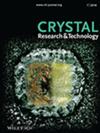原子氧和电子辐照对KTiOPO4晶体电子结构的影响
IF 1.9
4区 材料科学
Q3 CRYSTALLOGRAPHY
引用次数: 1
摘要
采用顶种溶液生长法制备了KTiOPO4晶体。利用空间摩擦原位分析系统研究了空间辐照对KTP晶体结构的影响:用原子氧(AO)和电子(EL)对KTP晶体(001)表面进行辐照,并用X射线光电子能谱(XPS)对其电子结构进行分析。AO具有较强的氧化性,导致c1s峰强度降低。AO/EL辐照后P含量升高,而Ti含量降低。还原后的ΔBE (O─P)经AO/EL辐照后,P─O键的离子性比原始的KTP晶体强。对o1s的光电发射谱线进行反褶积分析,发现530.8 ~ 531.0 eV和530.1 eV的峰分别属于O─P键和O─Ti键。此外,O─P键和O─Ti键含量的变化趋势与AO/EL辐照后P和Ti的变化趋势相似。本文章由计算机程序翻译,如有差异,请以英文原文为准。
Effect of Atomic Oxygen and Electron Irradiation on the Electronic Structure of KTiOPO4 Crystal
KTiOPO4 (KTP) crystals are prepared by the top‐seeded solution growth method. Effects of space irradiation on KTP crystal structure have been investigated using Space Tribology in‐situ Analysis System: KTP crystal (001) surfaces were irradiated by atomic oxygen (AO) and electron (EL), and the electronic structure was analyzed using X‐ray photoelectron spectroscopy (XPS). The AO has strong oxidizing property which results in decreases in the intensity of C 1s peak. The content of P increases after AO/EL irradiation, while the content of Ti decreases after AO irradiation. The reduced ΔBE (O─P) shows stronger ionicity of P─O bonds after AO/EL irradiation compared with pristine KTP crystal. The deconvolution of O 1s photoemission line reveals that peaks at 530.8–531.0 and 530.1 eV are assigned to O─P and O─Ti bonds, respectively. Additionally, variations in the trend of O─P bond and O─Ti bond contents are resembled to that of P and Ti after AO/EL irradiation.
求助全文
通过发布文献求助,成功后即可免费获取论文全文。
去求助
来源期刊
自引率
6.70%
发文量
121
审稿时长
1.9 months
期刊介绍:
The journal Crystal Research and Technology is a pure online Journal (since 2012).
Crystal Research and Technology is an international journal examining all aspects of research within experimental, industrial, and theoretical crystallography. The journal covers the relevant aspects of
-crystal growth techniques and phenomena (including bulk growth, thin films)
-modern crystalline materials (e.g. smart materials, nanocrystals, quasicrystals, liquid crystals)
-industrial crystallisation
-application of crystals in materials science, electronics, data storage, and optics
-experimental, simulation and theoretical studies of the structural properties of crystals
-crystallographic computing

 求助内容:
求助内容: 应助结果提醒方式:
应助结果提醒方式:


